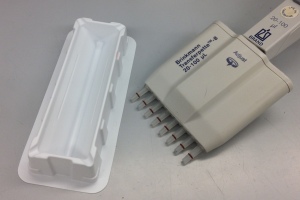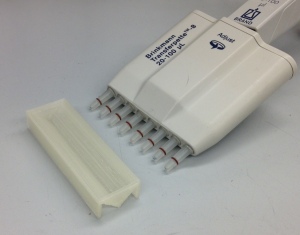One of the latest things we have in the lab’ is a 3D printer – a PrintrBot Simple Metal. I bought it over the summer and assembled it from a kit, which took about 5 hours. There are lots of things available to download and print from Thingiverse, or the NIH 3D print exchange, but if you want to make things from scratch, you need to learn to design in 3D using a program such as Sketchup. It’s free to download but there’s a steep learning curve and this was a big obstacle for me. Now I’m over that initial hump however, we can make things for the lab…
3D printed door-handle extension
The lab’ door opens outward, so opening it from the inside is easy when you’re laden with stuff or just wearing gloves – simply push and your elbow. BUT, if you’re outside and want to get in, you can’t pull the door handle with your elbow. So, I designed an extension to bolt onto the handle, providing a hook so you can pull the door open with your forearm, without touching anything with your hands. Here’s the finished article…
The .STL file is available here (in a zip folder because web host will not allow direct hosting of STL files) if you want to print your own. The screws used were standard 3/4″ steel sheet metal screws, the kind used for air duct work and available in packs of 100 at Home Depot. There’s a tab on the lower piece which grips against the ell in the metal handle, preventing it from spinning around. This one is for right handed opening doors, but in the next few days we plan to make one for left-handed doors too, and will update the STL then. The STL also contains some support material that has to be cut away after printing.
Trough for multi-pipeting small amounts
We use a Seahorse XF96 in the lab’. Each well has 4 drug-loading ports, but they only hold about 25 ul each. If you’re loading small amounts of expensive mitochondrial inhibitors (rotenone, FCCP etc.) the troughs typically available from lab-ware suppliers are just too big – twice as long as necessary and way too deep…
Our 3D printed version is a lot smaller, holding about 2ml instead of the usual 20-30 ml. Below is a picture, and the STL file is available here.
We’ve also played around with a few small dishes and chambers for patch clamping, various tube racks and holders, and some accessories for the PrintrBot itself. One issue we’ve come across is the water-tightness of flat printed surfaces – even with solid infill we seem to always end up with some leaks (hence the trough above was designed with angled walls that provide a much tighter seal). Also we’re not sure yet about the long-term durability of PLA in a lab setting. It’s a biodegradable corn plastic (polylactic acid), so might not hold up well to autoclaving etc. (we already had a tube rack deform when someone accidentally left the water bath cranked up to 70C).
We’ll be posting more STL models as they come.


